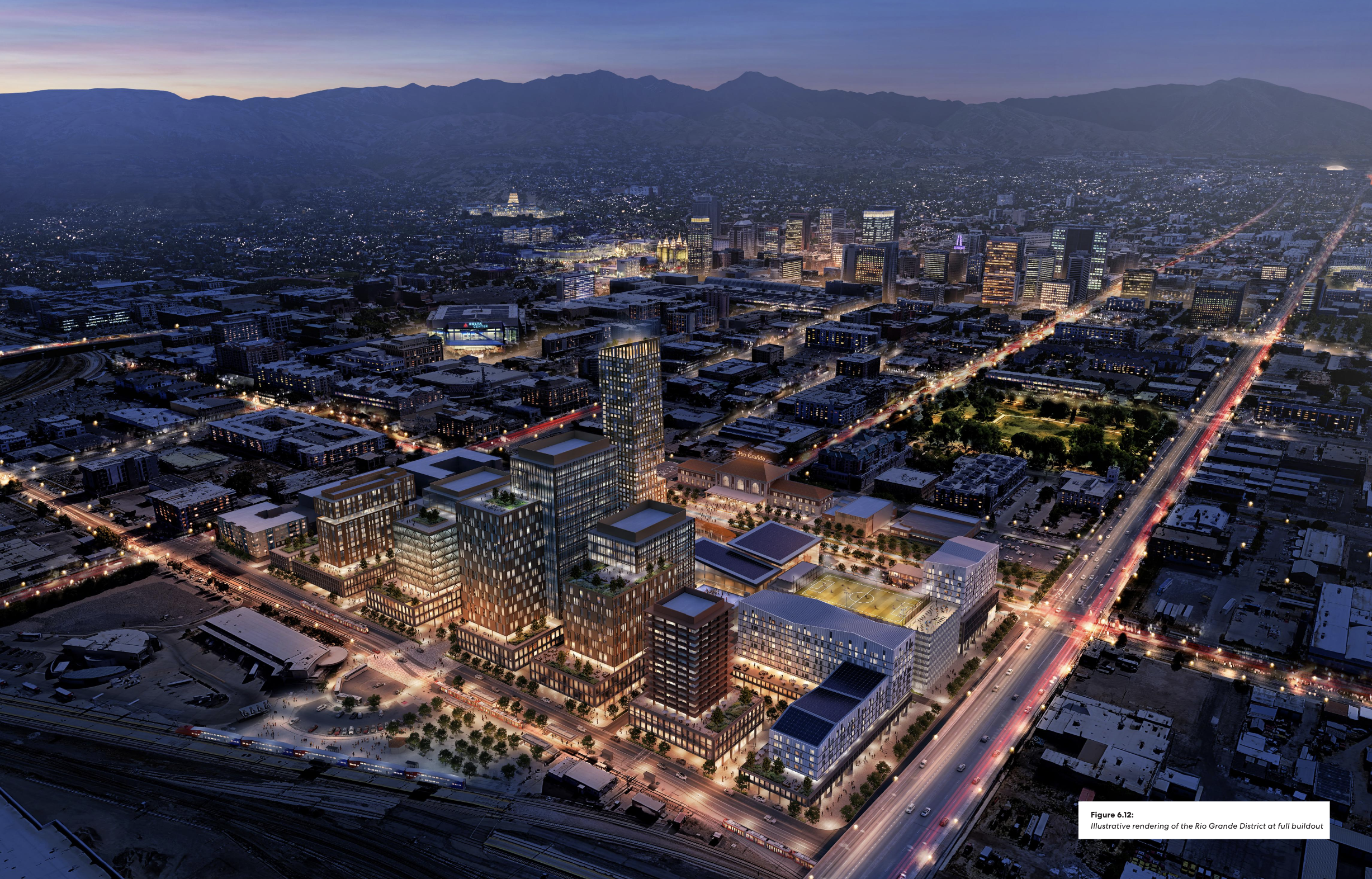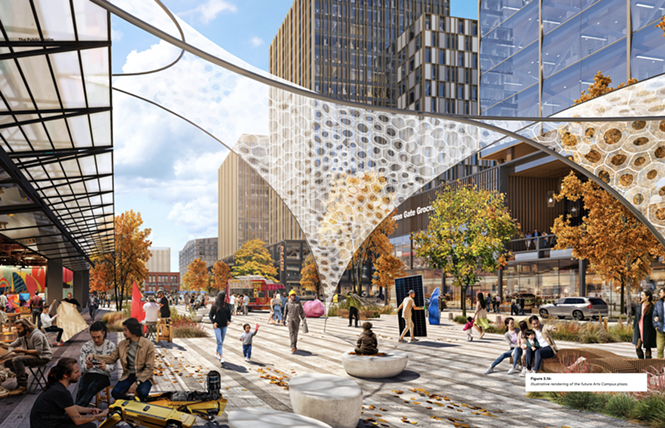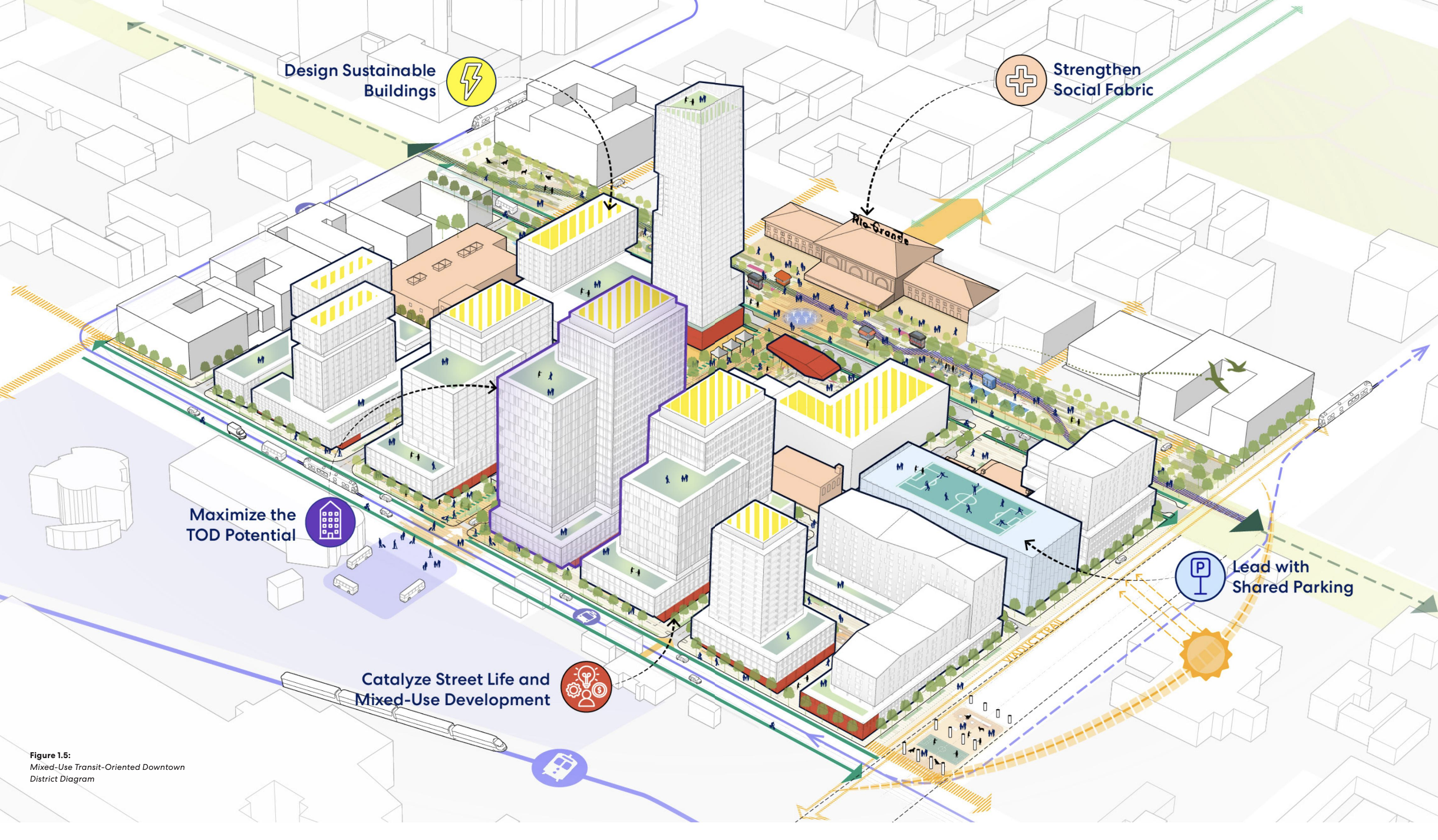‘Festival street,' Green Loop and transit-oriented density anchor latest SLC plans for west downtown.
Arrested Development
By Benjamin Wood @BjaminWoodSalt Lake City released its latest plans to fill in the area between the shuttered Rio Grande Depot and the lackluster Salt Lake Central Station this week, which if realized would see 300 South converted to a people-first “festival street” that runs through a new arts-focused pedestrian plaza before culminating at the proposed Green Loop linear park on 500 West.
In visioning documents prepared by the firm Perkins&Will on behalf of the city’s Redevelopment Agency (RDA), the long-dormant blocks between 400 South and 200 South on the western edge of downtown would be filled with new housing and retail amenities, a hotel, enhanced transit connections and mid-block walkways, green landscaping and even a micropark in the neglected space beneath the 400 South viaduct.
“This extensive document has truly captured the collective vision for the Rio Grande District and will serve as the strategic launchpad for its redevelopment,” Mayor Erin Mendenhall said in a prepared statement. “Thematically, the Plan thoughtfully addresses the neighborhood’s past, present, and future. Technically, it identifies and explores functional designs for spaces and buildings that will advance creativity, community wellness, economic growth and opportunities for all.”
The new plans are only the latest lofty proposal to transform the struggling Rio Grande area, where the RDA has tried for years to spur development of its city-owned and largely abandoned properties. But while previous efforts ran into dead ends, the Perkins&Will designs appear positioned to catalyze on broader development trends in Salt Lake City, like the Utah Transit Authority’s (UTA) efforts to expand and improve Trax and Frontrunner connections ahead of a likely 2034 Olympic Games, state investments around new professional sports franchises and the in-progress Green Loop project that will eventually ring downtown in walking and cycling trails by converting redundant vehicle lanes into space for pocket parks, plazas and other community amenities.
In a prepared statement, Perkins&Will principal Geeti Silwal said the Rio Grande District would become an “anchoring gateway” to Downtown Salt Lake City, with a rich urban fabric, diverse businesses and the fostering of a community where people of all ages and income levels can thrive.
“Designed as a low-carbon community, it leverages its proximity to a variety of transportation choices and provides a healthy, walkable environment,” Silwal said. “Serving as a bridge between downtown and west of downtown neighborhoods, the Rio Grande District will be a place of purposeful inclusive vibrancy. It will provide a nurturing environment for resident artists and non-profit organizations that give this district its distinct identity, and further promote the arts, culture and entrepreneurial spirit of the place."
Planned for development in phases, the RDA said work on the Rio Grande District would begin with upgraded utilities and street infrastructure in order to lay the groundwork for increased housing and retail density, much of which would then be privately initiated under mixed-use zoning regulations. New mid-block street connections would break up the area’s currently daunting scale into smaller, walkable zones and a new Arts Campus Alley that could serve as an outdoor venue, bordered by ground-level “maker spaces.” The 300 South “festival street” would also be reconstructed in such a way that car traffic could be shut down for community events.
Car parking would largely be limited to a multi-level structure off of 400 South—with the potential for a sport court or other public space on its roof—minimizing the presence of private vehicles and keeping driver traffic to a minimum in favor of walking, cycling and transit connections. The design is indicative of a new “park once” approach the city is taking to car traffic, with a similar multi-level structure currently under construction in the Granary District, located just south of the Rio Grande District.
“I am thrilled to support this transit-oriented development that lays the groundwork for an accessible and bustling area in our city,” said City Council member Alejandro Puy, who also serves as RDA Board chair.
But whether or not the area can overcome its longstanding challenges and truly thrive remains to be seen. While the street frontage along 600 West—where UTA’s Central Station is located—would be chock-full of transit-facing housing and retail, the efficacy of that station would remain hampered by a less-than-ideal location that sees its westward utility severed by Interstate 15 and the Union Pacific railyard.
A citizen-led proposal known as the Rio Grande Plan has called for the relocation of that train station back to the historic Rio Grande Depot—and the burying of rail lines in an underground “train box” on 500 West—which would put regional train service within walking distance of key destinations like the Delta Center and Pioneer Park, as well as facilitating a direct connection to proposed Trax light rail extensions on 400 West and 400 South.
Those Trax extensions are currently under study by UTA through its TechLink project, which seeks to create a new light rail line from Salt Lake International Airport to the University of Utah. One of the key questions of that study is whether this new “Orange” line would snake its way through the Rio Grande District or simply bypass Salt Lake Central and instead connect only to the more successful North Temple Frontrunner station, where multi-family housing development has accelerated.
While the Perkins&Will documents demonstrate an assumption that Salt Lake Central Station will remain the city’s primary Frontrunner stop—with the Rio Grande Depot reopened as a symbolic space and allowing pass-through pedestrian use on its ground floor—Rio Grande Plan co-creator Christian Lenhart said the designs would not preclude the city from pursuing a full reactivation of the historic rail depot in the future.
“While it is unfortunate that the plan does not go further towards endorsing or even mentioning the Rio Grande Plan, there is also no obvious conflict introduced by the update,” Lenhart said. “I am hopeful that this could be a step in the right direction.”
More by Benjamin Wood
-
Former Salt Lake City mayor and celebrated Utah Democrat Ted Wilson dies at age 84.
Ted Led
- Apr 11, 2024
-
Salt Lakers are about to miss an opportunity for reconnection over and under I-15.
Small Lake City
- Mar 27, 2024
-
Gov. Spencer Cox supports November ballot question on tax cuts; will sign bill targeting Salt Lake County DA
Doing the Math
- Mar 21, 2024
- More »
Latest in News
Readers also liked…
-
Raise a glass for E.L.T Harrison, architect of the Beerhive building on Main
Small Lake City
- Oct 11, 2023






